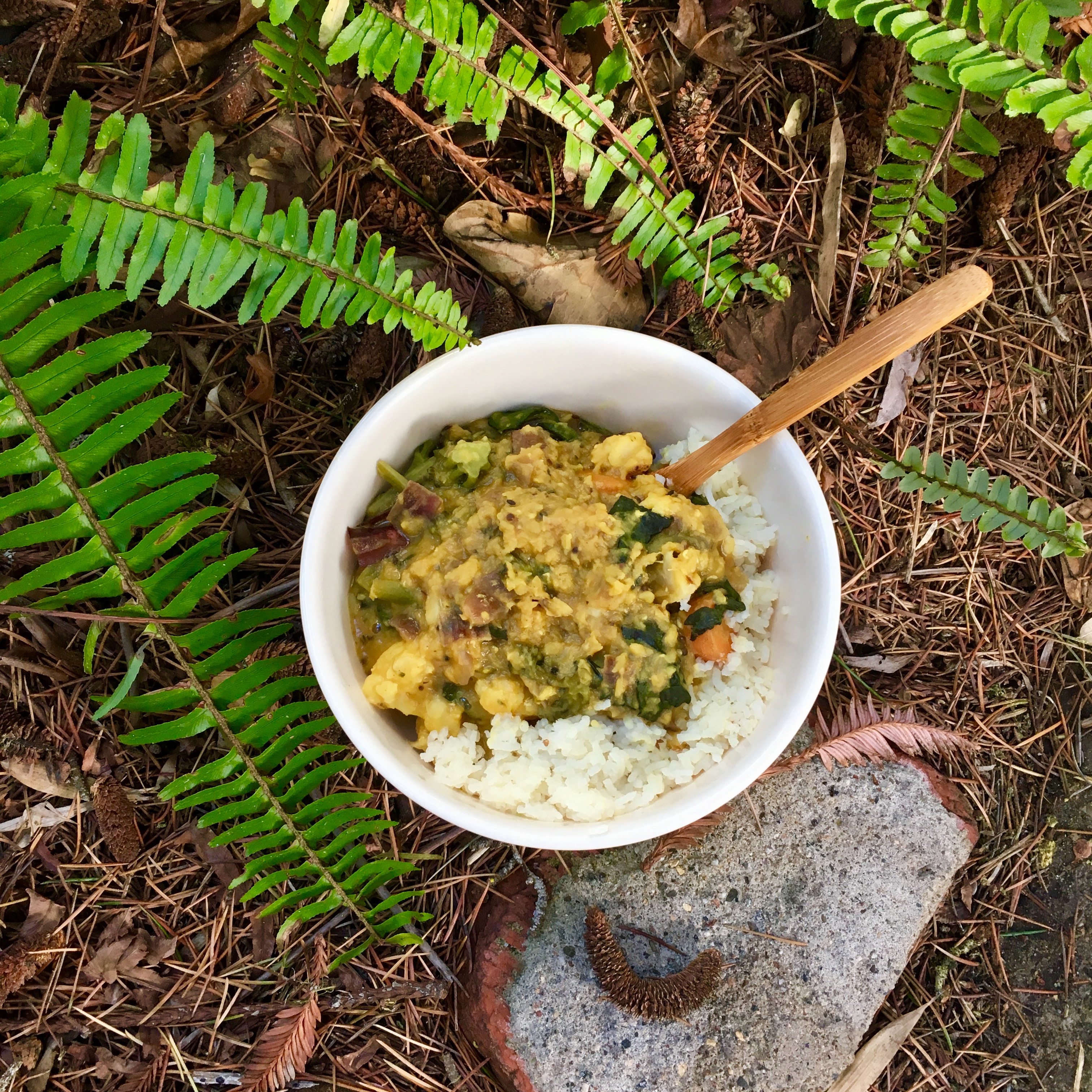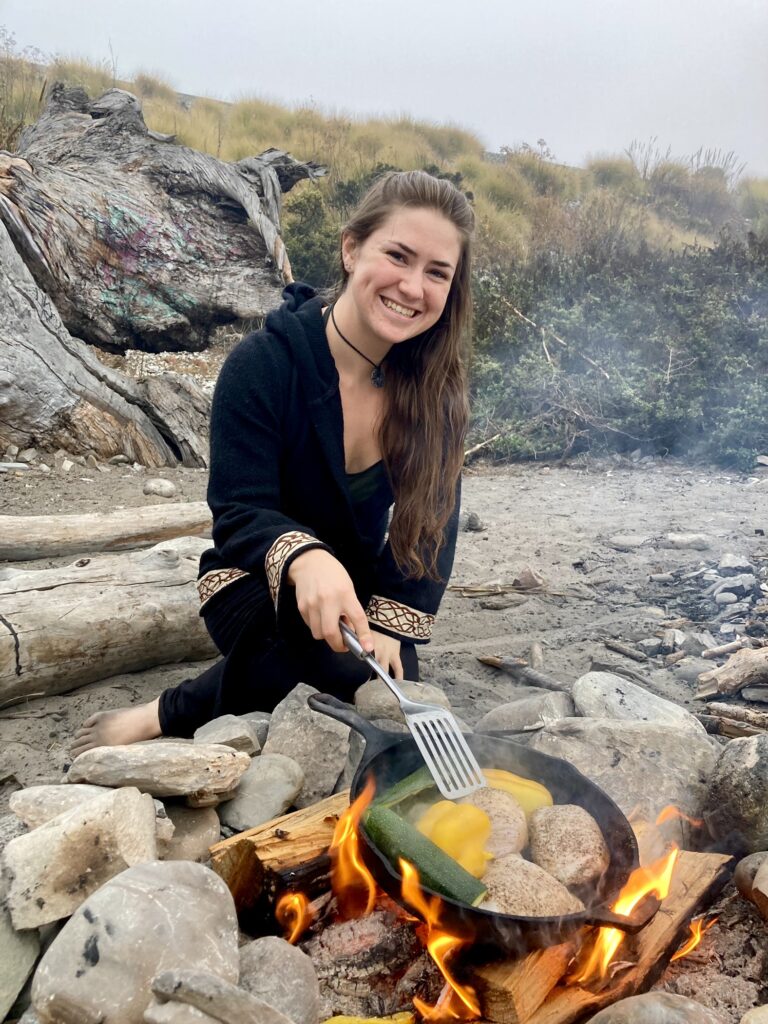Overcome Your Gut + Digestive Issues With Ancestral Nutrition
Veggie Dal and Rice

Dal and rice has been a staple meal in my life ever since I was a child. My dad use to make it for my brother and I when we were little and when I began cooking in 9th grade my dad taught me how to make it.
This traditional Indian dish is very healthy and delicious. It’s very light and cleansing and helps support a healthy digestion. If I’m ever feeling off, have a sluggish digestion, excess stomach acid, or excess ama (Ayurvedic term for mucus), a nice bowl of dal and rice helps me regain balance.


In this recipe I put a lot of veggies in the dal. Sometimes I will serve a plainer dal with a side dish of Indian spiced veggies, but lately I’ve been enjoying just throwing all my veggies straight into the dal. Since it is currently winter I put onions, carrots, cauliflower, broccolini, and kale in this dal. These are all veggies that grown locally in the winter time, at least they do here in California. Feel free to switch up the veggies with the seasons. Sometimes I’ll use tomatoes and chard in place of cauliflower, broccolini, and kale in the summer time. Anyways I hope you enjoy this traditional nourishing meal as much as I do!
With love from my kitchen to yours,
Kayley



Veggie Dal and Rice
Start by pouring the lentils into a pot. Rinse and drain them a few times to clean them off. Then cover with water and let them soak for 20 minutes. Do the same for your rice. Pour it in a bowl, rinse, drain, and soak the rice for 20 minutes. Once done soaking drain both the rice and lentils.
Meanwhile prepare your veggies by chopping them. Make sure you cut them all about the same size so that they will cook evenly. Heat oil or fat over medium high heat. Once hot add cumin seeds, mustard seeds, asafoetida, and the dried chili halves. When the seeds start to pop and brown add onion and cook for about 3 minutes. Then add carrots, cauliflower, and broccolini. Stir veggies often. After about 10 minutes add ginger, garlic, and a dash of salt. Once the veggies are a few minutes away from being done add kale. The veggies are done when they are soft and fork tender.
While the veggies are cooking, go back to the dal. Add 2 1/2 cups fresh water and the drained lentils to a medium sized pot. Bring to a boil over high heat. When the dal boils some foam will form on the surface of the water, gently brush the foam off into the sink without getting rid of the water, reduce heat to medium low, add turmeric and salt, and cook partially covered for 20 minutes. Stir occasionally. Once done, add veggies and curry powder. If your dal is too watery boil off some of the water uncovered for a few minutes. If its too dry add more water. Once you reach your desired consistency, remove from heat and stir in lemon juice.
Meanwhile, make the rice. Start by boiling some water in a pot. In a separate pot, heat oil or fat over medium heat. Once hot add cumin seeds. When they start to brown add the drained rice and cook for a few minutes till the rice pearls. Pearling of rice refers to when the rice gets a bold white color and no longer appears translucent. Then add salt and 3/4 cup boiling water and bring to a boil. Reduce heat to low and cook covered for 8 minutes for white rice and about 16-20 minutes for brown rice. Then turn off heat and let rice sit untouched for an additional 5-10 minutes. Boil off any additional water uncovered for a minute or so.
Divid the rice and veggies amongst two bowls, serve, and enjoy!
Ingredients
Directions
Start by pouring the lentils into a pot. Rinse and drain them a few times to clean them off. Then cover with water and let them soak for 20 minutes. Do the same for your rice. Pour it in a bowl, rinse, drain, and soak the rice for 20 minutes. Once done soaking drain both the rice and lentils.
Meanwhile prepare your veggies by chopping them. Make sure you cut them all about the same size so that they will cook evenly. Heat oil or fat over medium high heat. Once hot add cumin seeds, mustard seeds, asafoetida, and the dried chili halves. When the seeds start to pop and brown add onion and cook for about 3 minutes. Then add carrots, cauliflower, and broccolini. Stir veggies often. After about 10 minutes add ginger, garlic, and a dash of salt. Once the veggies are a few minutes away from being done add kale. The veggies are done when they are soft and fork tender.
While the veggies are cooking, go back to the dal. Add 2 1/2 cups fresh water and the drained lentils to a medium sized pot. Bring to a boil over high heat. When the dal boils some foam will form on the surface of the water, gently brush the foam off into the sink without getting rid of the water, reduce heat to medium low, add turmeric and salt, and cook partially covered for 20 minutes. Stir occasionally. Once done, add veggies and curry powder. If your dal is too watery boil off some of the water uncovered for a few minutes. If its too dry add more water. Once you reach your desired consistency, remove from heat and stir in lemon juice.
Meanwhile, make the rice. Start by boiling some water in a pot. In a separate pot, heat oil or fat over medium heat. Once hot add cumin seeds. When they start to brown add the drained rice and cook for a few minutes till the rice pearls. Pearling of rice refers to when the rice gets a bold white color and no longer appears translucent. Then add salt and 3/4 cup boiling water and bring to a boil. Reduce heat to low and cook covered for 8 minutes for white rice and about 16-20 minutes for brown rice. Then turn off heat and let rice sit untouched for an additional 5-10 minutes. Boil off any additional water uncovered for a minute or so.
Divid the rice and veggies amongst two bowls, serve, and enjoy!
Notes
Nutrition:
|
Ingredients |
Cals |
Fat |
Carbs |
Protein |
|
1/2 cup red lentils |
343.5 |
2.1g |
60.5g |
23g |
|
1/2 onion (132g) |
57.4 |
0.3g |
13.3g |
1.8g |
|
2 small carrots (86g) |
36 |
0.2g |
8.3g |
0.8g |
|
1 1/3 cups cauliflower, chopped (165g) |
38.6 |
0.7g |
6.8g |
3.1g |
|
2/3 cup broccoli, chopped (105g) |
36.9 |
0.4g |
7.4g |
2.5g |
|
3 leaves of kale (130g) |
36 |
0.5g |
7.3g |
2.5g |
|
2 tsp oil |
86.7 |
9.3g |
0g |
0g |
|
1/2 cup white basmati rice |
320 |
0g |
72g |
6g |
|
Total (serves 2) |
955.1 |
13.5g |
168.8g |
39.7g |
|
1 serving |
477.6 |
6.8g |
84.4g |
19.9g |
Notes:
- Sprouting rice increases the bioavailability of nutrients. The process of germination increases levels of “levels of gamma-aminobutyric acid (GABA), magnesium, potassium, and zinc, as well as the phytonutrients ferulic acid and gamma oryzanol” (3). Sprouting also helps decrease anti-nutrients (molecules that bind to nutrients inhibiting their absorption) like phytates, saponins, and lectins (4). You can buy rice that has already been sprouted or you can practice this ancient method yourself.
- Sprouting lentils also decreases anti-nutrients and makes the lentils easier to digest. This causes an increase in nutrient absorption. You can buy pre-sprouted lentils or sprout them yourself.
- How to Sprout Rice and Lentils:
- “Place rice or lentils in a quart-size sprouting jar or other sprouting container. Fill with water, cover with a sprouting screen or mesh sprouting lid. Soak 12 hours or overnight.
- Drain off water.
- Invert the jar over a bowl at an angle so that the rice will drain and still allow air to circulate.
- After 12 hours of draining, rinse and drain again.
- Repeat rinsing and draining 1-3 times daily.
- Tiny sprouts should begin to poke out from the rice or lentils in 1-3 days. At this point, sprouting is complete.
- Drain the sprouts well and transfer to a covered container” (5).
- Nutrition is based on the products I use. I provide a nutrition table so that you can quickly check to see if your food products match or so that you can easily calculate the nutrition for any changes you want to make to the recipe. I think this helps if you have very specific diet goals and/or fitness and/or health goals. I also wanted you to be able to see exactly where I get the numbers for my nutrition facts so that you can see that they are reliable and learn more about macro breakdowns of food.
- I only calculated half the oil because a lot of it sticks to the pan.
Works Cited
1. Nutritionix. Gladson. https://www.nutritionix.com/ Accessed 21 January 2019.
2. Eat This Much. https://www.eatthismuch.com/ Accessed 13 June 2019.
3. Layarda, Sofia. “Sprouted Brown Rice: Health Benefits and How-To.” Health Castle.12 March 2013. https://www.healthcastle.com/sprouted-brown-rice-health-benefits-and-how-to/
4. “Antinutrients.” Nutrients Review. Accessed 21 August 2020. http://www.nutrientsreview.com/antinutrients
5. “How to Sprout Brown Rice.” Culture for Health. Accessed 21 August 2020. https://www.culturesforhealth.com/learn/sprouting/how-to-sprout-brown-rice/

